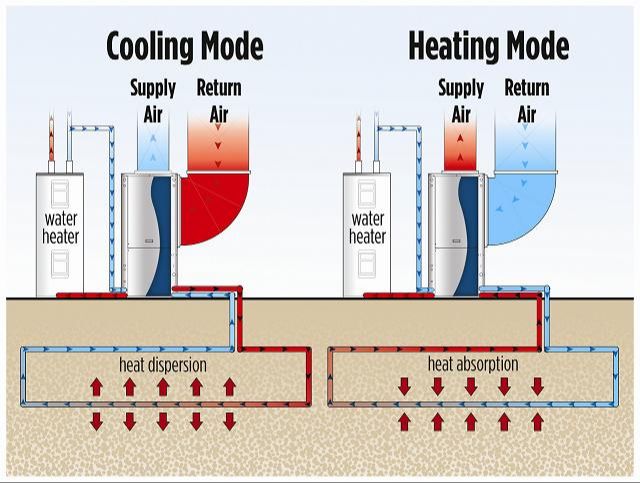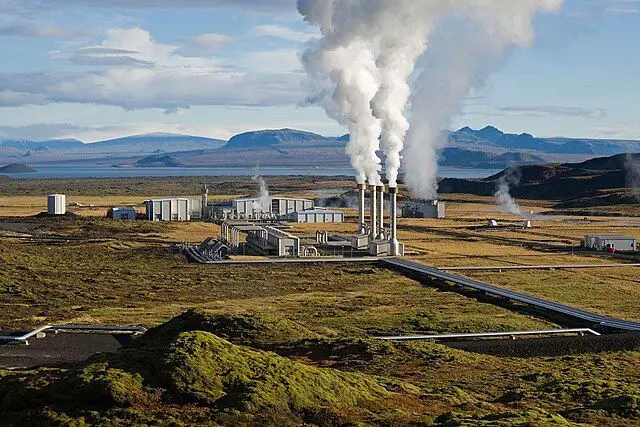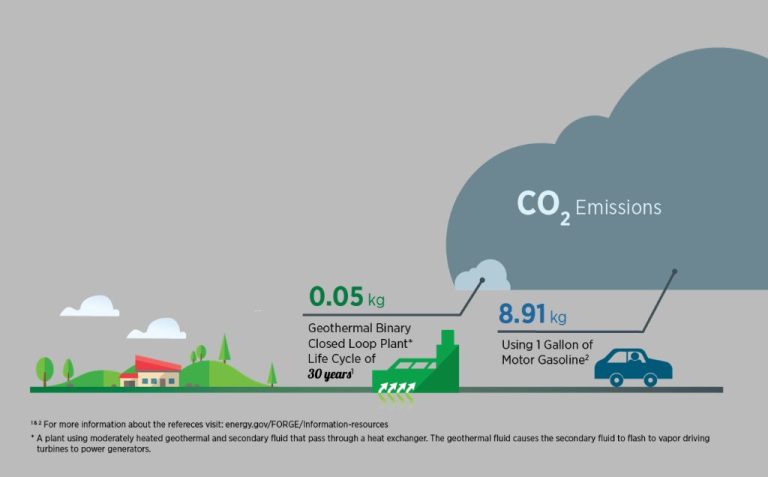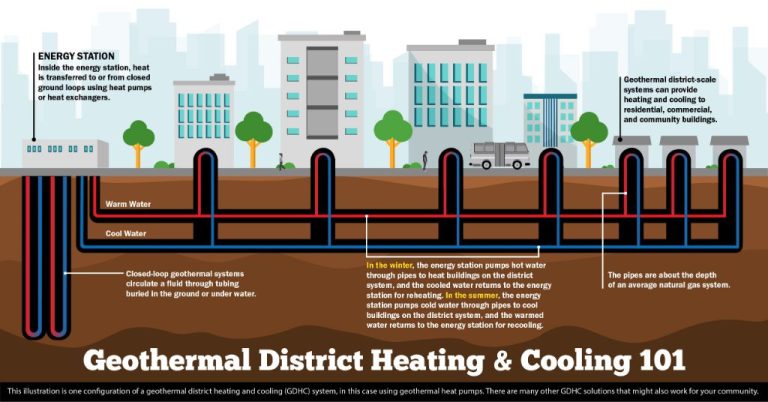How Is Geothermal Energy Made?
What is Geothermal Energy?
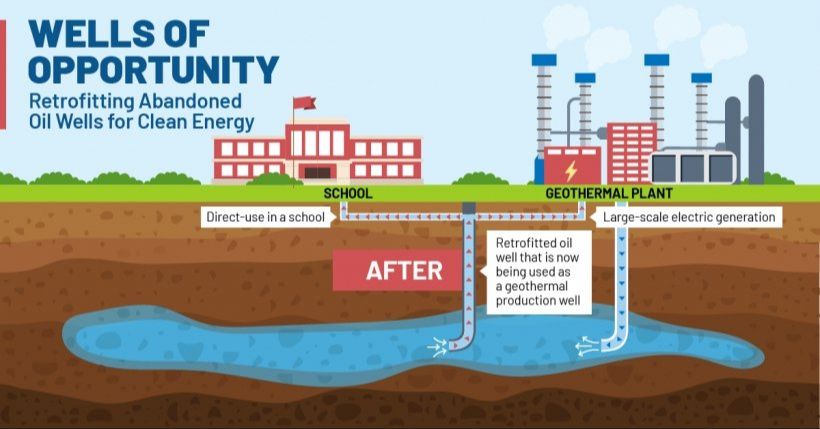
Geothermal energy is heat energy generated and stored under the earth’s surface. The word “geothermal” comes from the Greek words “geo” meaning earth, and “therme” meaning heat. Geothermal energy is a renewable energy source because the heat is continuously produced inside the Earth (1).
There are three main types of geothermal energy systems that are used to extract heat energy from the Earth (2):
- Hydrothermal systems – Natural reservoirs of steam or hot water that exist in underground rocks and can be tapped into.
- Geopressured systems – Hot water under pressure trapped in permeable rock. When tapped, the hot water flashes to steam.
- Hot dry rock systems – No natural water or steam exists. Water is pumped down into the hot rocks forcing open existing cracks and enabling the capture of the heated water.
The high temperature hydrothermal systems are currently the most common type used for geothermal power generation around the world (3).
(1) https://www.eia.gov/energyexplained/geothermal/
(2) https://www.energy.gov/eere/geothermal/geothermal-basics
(3) https://www.twi-global.com/technical-knowledge/faqs/geothermal-energy
How Geothermal Energy is Formed
Geothermal energy comes from the heat within the Earth. At the Earth’s core, temperatures can reach over 9,000 degrees Fahrenheit. This heat is generated from a combination of factors:
The decay of radioactive elements like potassium, uranium, and thorium present in the Earth’s crust. As these elements decay, they produce heat.
Heat left over from the planet’s formation about 4.5 billion years ago, when gravity compressed the planet’s molten core.
Frictional heating caused by denser material sinking to the center of the planet.
The further underground you go, the hotter it gets. The high temperatures underground heat up water and rock, creating geothermal reservoirs that can reach up to 700 degrees Fahrenheit. This hot water and steam can be tapped as a renewable energy source.
Geothermal energy is often found along tectonic plate boundaries where volcanic activity occurs. As tectonic plates move and collide with each other, they produce areas of high heat flow known as “hot spots.” These regions, like Iceland and Yellowstone National Park, have abundant geothermal resources.
Locations with Geothermal Resources
Geothermal energy is found in areas with volcanic activity and hot spots below the earth’s surface. The western United States, Alaska, and Hawaii have substantial geothermal resources due to the geologic activity in the Pacific Rim. Other countries like Iceland, New Zealand, Philippines, Indonesia, and parts of Central America also have abundant geothermal energy potential.
Some key geothermal regions include:
- The Pacific Ring of Fire – This region along the edges of the Pacific Ocean has high volcanic and seismic activity. Countries like the USA, Mexico, New Zealand, Indonesia, and Philippines in this zone can tap geothermal reservoirs.
- Iceland – The island nation sits atop the Mid-Atlantic Ridge and has ample geothermal resources, meeting close to 30% of its energy needs from geothermal.
- Yellowstone National Park – This supervolcano in Wyoming has huge amounts of underground heat that can be harnessed for geothermal power.
Geothermal plants require heat reservoirs with temperatures exceeding 150°C which are often found along tectonic plate boundaries and active volcanic regions. Countries blessed with these geologic conditions are the ideal locations for geothermal energy development.
Extracting Geothermal Energy
Geothermal energy is extracted by drilling wells deep into the Earth to reach areas with high temperatures closer to the Earth’s core. Typically, wells are drilled up to 2 miles deep to reach temperatures above 150°C that can produce electricity. The wells bring hot water or steam to the surface that can power a turbine to generate electricity.
There are three main types of geothermal power plants used for electricity generation:
- Dry steam plants use steam from the reservoir to directly spin the turbine generators. They are the oldest type of plant but require very hot temperatures above 235°C. According to the EPA, the world’s first geothermal power plant opened at Lardarello in Italy in 1904 and ran on dry steam.
- Flash steam plants take high pressure hot water from deep wells and convert it to steam to drive turbine generators. They can operate with lower temperature water above 180°C. Flash plants are the most common type today.
- Binary cycle plants transfer the heat from the hot water to another liquid with a lower boiling point, usually an organic compound. The vapor from this second liquid spins the turbines. Binary plants can operate with lower temperature water down to 57°C.
This allows electricity generation in areas with lower temperature geothermal resources. According to ScienceDirect, binary cycle plants now generate the most geothermal power worldwide.
Uses of Geothermal Energy
Geothermal energy has a wide variety of uses, primarily electricity generation, heating and cooling, and industrial applications.
One of the main uses of geothermal energy is for electricity generation. Hot water or steam from geothermal reservoirs can be piped directly to power plants where it turns turbines to generate electricity. According to the U.S. Department of Energy, geothermal power plants generated about 17 billion kilowatt-hours of electricity in 2019, which was 0.4% of total U.S. electricity generation. https://www.energy.gov/eere/articles/5-things-know-about-geothermal-power
Another major use is for heating and cooling. A geothermal heat pump system can tap into subsurface temperatures to heat and cool buildings very efficiently. This direct use of geothermal energy provides heating and cooling for an estimated 600,000+ homes and other buildings in the United States. Geothermal heat pumps can reduce energy use by up to 50% compared to traditional heating and cooling systems.
Industrial applications of geothermal energy include food dehydration (drying), gold mining, and milk pasteurizing. The heat from geothermal fluids can be used directly or indirectly to process or dry fruits, grains and vegetables. Geothermal resources are also used to process raw materials like silica, and in gold mines to extract gold from ore.
Advantages of Geothermal
Geothermal energy offers several key advantages over conventional energy sources:
It is renewable. Geothermal energy comes from the natural heat inside the Earth, which is constantly being replenished and will never run out as long as the Earth exists. This makes it a sustainable long-term energy solution.
It is reliable. Geothermal plants can run 24/7, unaffected by weather conditions or external energy markets. Capacity factors for geothermal plants are typically over 90%, much higher than intermittent sources like wind and solar.
It reduces fossil fuel use. Geothermal power generation emits little to no greenhouse gases. Expanding geothermal energy can directly displace fossil fuel electricity generation, helping combat climate change. According to this article, geothermal energy has the potential to meet 3-10% of U.S. baseload electricity demand.
Disadvantages of Geothermal
While geothermal energy has several advantages, there are some downsides to consider as well:
High upfront costs are one disadvantage. Constructing a geothermal power plant requires significant capital investment upfront before energy production can begin. Drilling wells thousands of feet deep and installing pipelines and power plant infrastructure drives up costs compared to some other energy sources 1.
Another downside is geothermal’s limited location. Geothermal energy can only be harnessed where there are adequate subsurface hot water and steam reservoirs. This limits geothermal plants to certain geographical locations, usually along tectonic plate boundaries or volcanic hotspots 2.
There are also potential emissions if not managed properly. Geothermal sites can release hydrogen sulfide and carbon dioxide if the reservoirs aren’t properly capped or filtered. Proper maintenance and emission controls are needed to prevent harmful discharge into the atmosphere.
Environmental Impacts
Geothermal energy has several environmental impacts that need to be managed. Two of the main areas of concern are land use and emissions, and water use.
In terms of land use, geothermal plants take up a relatively small amount of space compared to other energy sources. However, there can be emissions of hydrogen sulfide and carbon dioxide if not properly controlled. Emissions can be minimized by recycling these gases back into the reservoir. Careful reservoir management is important to avoid subsidence (sinking of the ground) and depletion over time.1
Water usage is another important consideration. Geothermal plants use water for cooling and to pump the geothermal fluid through the system. The geothermal water extracted from the reservoirs also contains trace amounts of chemicals like boron, arsenic, and mercury that need to be properly disposed of. Reinjecting the geothermal water back into the reservoir helps minimize freshwater consumption and disposal issues.2
Future of Geothermal
The future looks bright for geothermal energy, especially with new technologies like enhanced geothermal systems (EGS) and co-production with oil and gas.
EGS allows geothermal energy production in areas that don’t have ideal hydrothermal resources. It works by artificially fracturing hot rock, circulating fluid through the fractures to capture the heat, and bringing it to the surface. EGS has the potential to dramatically increase geothermal capacity in the future. According to the MIT Future of Geothermal Energy study, EGS could provide 100 GW of electrical capacity in the United States alone.
Co-production involves using the same wells to produce both geothermal energy and oil/gas. This can make marginal oil and gas wells more profitable while also harnessing geothermal energy that would otherwise go untapped. The DOE estimates there are more than 4 million abandoned oil and gas wells in the U.S. that could potentially be used for geothermal co-production.
With innovative technologies like EGS and co-production, geothermal is poised to play a major role in the global renewable energy mix going forward.
Key Takeaways
Geothermal energy is a renewable energy source that taps into the natural heat within the earth to produce electricity and heat homes. The earth’s core is constantly producing heat, which gets transferred to hot rocks, reservoirs, and water sources underground. Wells and piping systems can bring this geothermal energy to the surface to generate electricity, provide heating, or be used for various industrial processes.
Geothermal energy offers several benefits as a renewable resource. It produces minimal emissions, can provide constant “baseload” power not reliant on weather conditions, and utilizes existing heat rather than combusting fuels to generate energy. However, it does require favorable geographic conditions, emits some greenhouse gases, and can have environmental impacts if not managed properly. Overall, as technology improves, geothermal has the potential to play a larger role in the world’s transition to renewable energy and reduced carbon emissions.
Developing geothermal and other renewable energy sources is crucial for creating a sustainable future and mitigating climate change. The earth offers many forms of renewable power if we utilize them responsibly. Geothermal energy demonstrates our capability to tap into natural systems to produce the power we need in an eco-friendly way.

